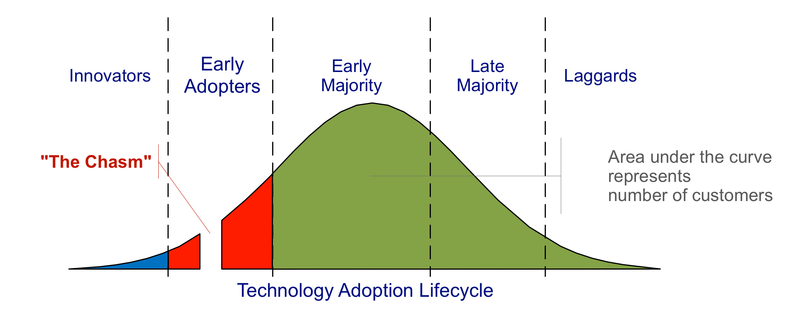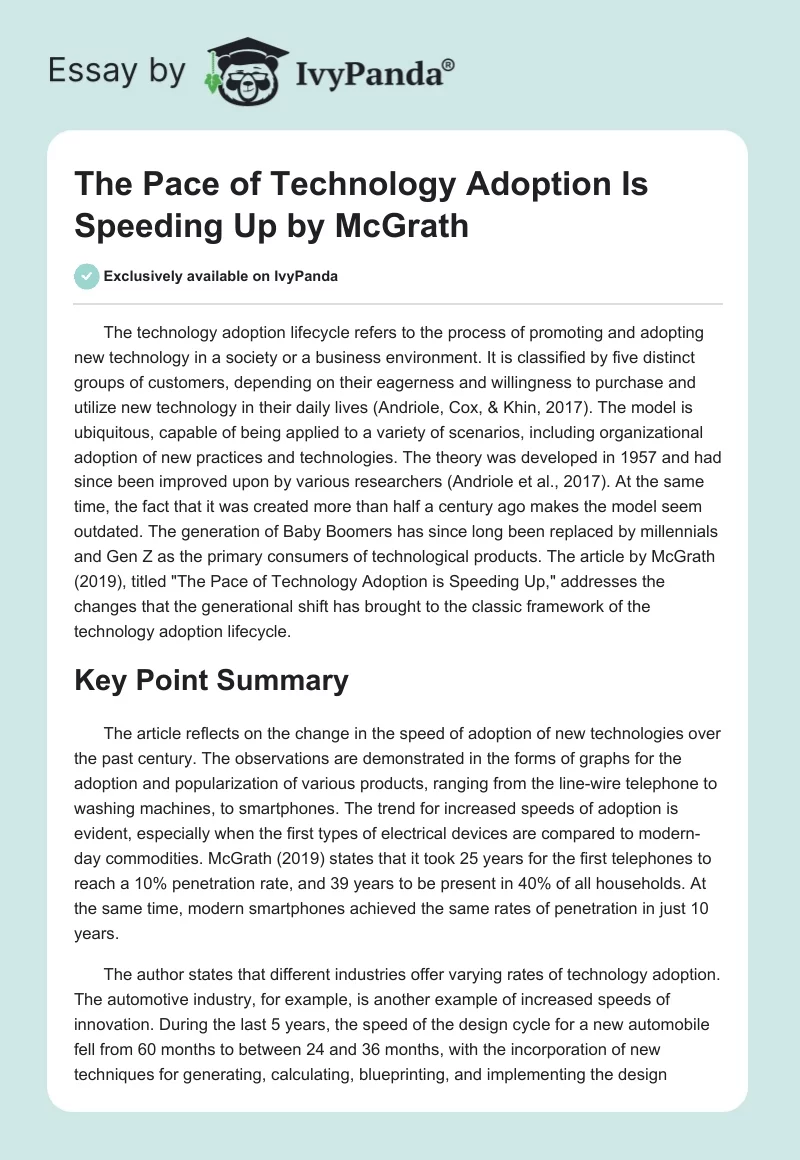The technology adoption lifecycle refers to the process of promoting and adopting new technology in a society or a business environment. It is classified by five distinct groups of customers, depending on their eagerness and willingness to purchase and utilize new technology in their daily lives (Andriole, Cox, & Khin, 2017). The model is ubiquitous, capable of being applied to a variety of scenarios, including organizational adoption of new practices and technologies. The theory was developed in 1957 and had since been improved upon by various researchers (Andriole et al., 2017). At the same time, the fact that it was created more than half a century ago makes the model seem outdated. The generation of Baby Boomers has since long been replaced by millennials and Gen Z as the primary consumers of technological products. The article by McGrath (2019), titled “The Pace of Technology Adoption is Speeding Up,” addresses the changes that the generational shift has brought to the classic framework of the technology adoption lifecycle.
Key Point Summary
The article reflects on the change in the speed of adoption of new technologies over the past century. The observations are demonstrated in the forms of graphs for the adoption and popularization of various products, ranging from the line-wire telephone to washing machines, to smartphones. The trend for increased speeds of adoption is evident, especially when the first types of electrical devices are compared to modern-day commodities. McGrath (2019) states that it took 25 years for the first telephones to reach a 10% penetration rate, and 39 years to be present in 40% of all households. At the same time, modern smartphones achieved the same rates of penetration in just 10 years.
The author states that different industries offer varying rates of technology adoption. The automotive industry, for example, is another example of increased speeds of innovation. During the last 5 years, the speed of the design cycle for a new automobile fell from 60 months to between 24 and 36 months, with the incorporation of new techniques for generating, calculating, blueprinting, and implementing the design (McGrath, 2019). Computing technology had a significant effect on the process, allowing companies to create prototypes and generate models faster and more efficiently than ever before.
McGrath (2019) concludes the article by stating that the primary factors responsible for increased rates of technology adoption are as follows:
- The increased number of players on the market – the accessibility of the technological market made development a venue available to smaller companies, not just big ones;
- Reduced barriers to technology trading and commerce – many startups utilize the available operating systems and well-known technological principles to build up and improve on the design;
- Higher rates of competition – large manufacturers are driven to create new technologies and release them into the market to maintain a competitive advantage.
Discussion and Implications for Marketing Practitioners
The article serves to demonstrate the outdated notions of the existing technology lifecycle, as presented to us by the classical theory of technology adoption. According to Fig. 1, the majority of customers could be found in the third and fourth subcategories, those being the early and the late majority. While such a bell curve applied to Boomers and Gen X, Millennials and Gen Z are characterized by increased levels of technical acumen that previous generations, at large, do not possess (Andriole et al., 2017). This was demonstrated by the ever-shortening times that pass between the introduction and full-scale adoption of technologies.

Thus, the customer majority has shifted to the left, with many individuals of the new generation being early adopters of all new technology. At the same time, the difference between the late majority and laggards becomes insignificant, to the point it would make sense to unite the last two groups of customers into one. Accordingly, the chasm that determines whether the technology sees success or drops off has also been shifted to the left, affected by innovation rather than at the early adoption stage.
These changes have a series of direct implications for marketers. The first implication is that it would be possible to achieve higher levels of market penetration in shorter amounts of time. This is explained by the fact that roughly 70% of the customers are now innovators and early adopters (Andriole et al., 2017). The second implication is that it becomes possible to tell whether the new technology will or will not be adopted at an earlier stage. As a result, it is possible to save money and prevent overcommitment on ventures that seem promising but fail to cross the chasm, which has always been an issue for any innovative products.
Finally, the speed of adoption also means that the product will lose its novelty and become the new standard in a relatively short amount of time (Andriole et al., 2017). This would reduce the length of the technology lifecycle and force the competitors to continuously improve and update their products to remain in the game. All three implications are beneficial to companies with a high emphasis on research and development, as it makes creating new technologies more profitable and less risky in the short-term perspective.
Personal Reaction and Recommendations
The information provided by the article proved what I already knew from class as well as from personal experience – the speed of technology adoption is changing due to a variety of factors, including the technological acumen of the population. Indeed, had Apple’s iPhone taken 25 years to achieve 10% market penetration; it would not have been a very profitable venture in the realities of the modern economy (Andriole et al., 2017). However, the article gives only a glancing perspective on the subject, offering statistics without explaining the factors that influence the speed of technology adoption. While generational differences play a major part in the trend, they are not the main reasons behind the shifts in the technology adoption lifecycle.
As it is possible to see from the graphs provided in the article, the technologies that took the longest to achieve market penetration were also those that laid the infrastructure to be used by future technologies (Mullakhmetov, 2018). Electricity, radio, telephone, and television were the basis for modern-day tech, including wired and wireless Internet and mobile connectivity. The first Internet lines utilized phone wires to transmit data, and the first mobile towers were based on the present radio grid (Mullakhmetov, 2018). Thus, Millennials and Gen Z were placed in a position to acquire and adopt new technologies much easier than the previous generations.
It is recommended for the article to focus in greater detail on the matters of technological literacy, existing infrastructure, and means of production as the primary factors behind the lean on the left for the lifecycle. At the same time, the conclusion that any technology would have an easier time getting adopted should be revised. Should a new product be developed that does not rely on modern means of production and communication, the developers would be forced to build up the infrastructure for it from the ground up. Such a technology would take more time to penetrate the market, mirroring the history of earlier devices.
References
Andriole, S. J., Cox, T., & Khin, K. M. (2017). the innovator’s imperative: Rapid technology adoption for digital transformation. Boca Raton, FL: Auerbach Publications.
McGrath, R. G. (2019). The pace of technology adoption is speeding up.Harvard Business Review. Web.
Mullakhmetov, K. (2018). Technological factors and management transformation in social and economic systems. European Research Studies Journal, 21(3), 230-241.


